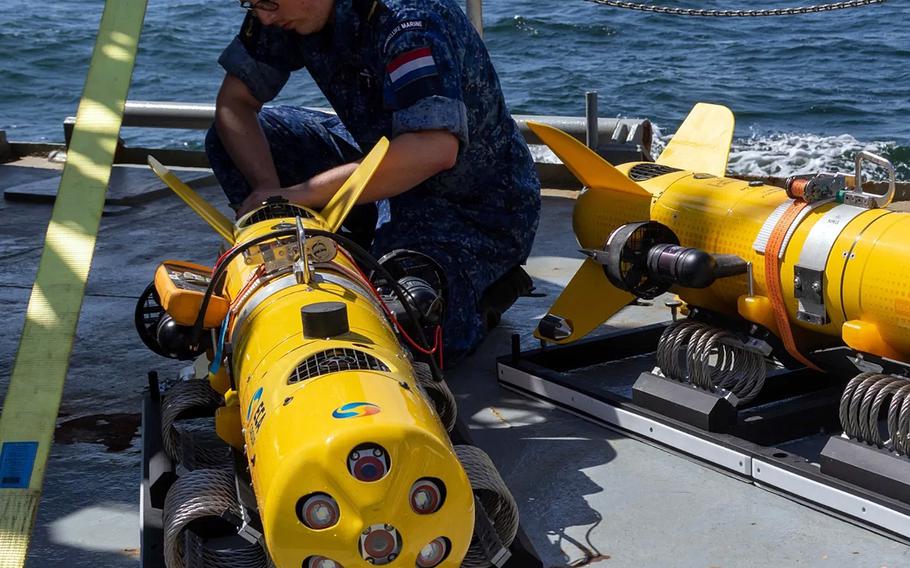
An underwater drone is prepared on a Dutch navy ship during mine countermeasure training at the Baltic Operations exercise in June 2024, which is taking place in the Baltic Sea. The U.S. Navy in Europe is working with allies on setting common operations standards for drones and emerging technology. (Jan Eenling/Dutch navy)
NAPLES, Italy — U.S. Navy officials met with allies and partners in Portugal this week to discuss common standards for drones and emerging technology, as the service learns from trends in warfare playing out in Ukraine and other global hot spots.
The talks at the Portuguese Navy Operational Experimentation Center in Troia included devising guidelines for industry contractors and creating the standardization needed so NATO forces can work together effectively.
The Navy wouldn’t offer specifics, but the conversation was productive and it was “exciting to have this kind of dialogue with allies and partners, sharing ideas and knowledge in such an evolving battlespace,” U.S. Naval Forces Europe-Africa/U.S. 6th Fleet said in a statement Thursday.
The center, affiliated with a NATO project aimed at spurring technological advancement, is recognized for its expertise in drones and new technologies.
The discussions come as the Navy in Europe and Africa endeavors to rapidly add drones and other systems to the surface, underwater, air, land, information and space domains.
In November, the service established Task Force 66 at its base in Naples. The task force was integrated into the fleet last month.
The 40-member military and civilian team works alongside government, industry and academic experts to develop and field capabilities throughout Europe and Africa, said Rear Adm. Michael Mattis, director of strategic effects for NAVEUR-AF and commander of the task force.
“It’s really driven by the evolving threat environment … and the need for the Navy to evolve,” said Mattis, who likened the task force to the Air Force’s 603rd Air Operations Center in Ramstein, Germany, and the Army’s 2nd Multi-domain Task Force in Mainz-Kastel, Germany.
The use of drones in the Russia-Ukraine war, their proliferation in the Red Sea and concerns about how the fleet would fare against the technology in a South China Sea conflict have spurred the Navy to step up its efforts.
For example, an MQ-4C Triton drone detachment recently was deployed to Naval Air Station Sigonella in Sicily.
The service also is experimenting with drones in Africa, and unmanned undersea vehicles are being used to counter mines during the multinational BALTOPS exercise in the Baltic Sea.
“The nations which adapt quickly to new technology and integrate these capabilities will have the advantage,” Chief of Naval Operations Adm. Lisa Franchetti told Stars and Stripes during a visit to Naval Support Activity Bahrain on June 4.
European allies such as the U.K., France and Latvia also are driving drone experimentation and innovation, said Sebastian Bruns, a German maritime security expert and senior researcher for the Institute for Security Policy at Kiel University.
Those efforts are rooted in concern that Russia’s industrial base likely will outmatch that of the West for the foreseeable future when it comes to churning out ships, submarines and other conventional vessels, Bruns said.
That means the U.S. and its NATO allies and partners must become more savvy, nimble and focused on developing new technologies and using them in unconventional ways, he said.
“NATO realizes that it has to outsmart and outthink and out-innovate the Russians,” Bruns said. “What we see now is the need, the desire really, to connect these dots and tie these efforts together … into a cooperative and really coordinated endeavor.”
Among CTF-66’s objectives is adopting the mentality of a startup business, Mattis said.
“That’s a very different and challenging way of doing business compared to how the Navy does business in the standard way,” Mattis said. “We’re going to try to fail fast and learn from that failure early on.”
Recently, team members coordinated with the manufacturer of a surface drone being tested in Africa to quickly identify a problem with how data was being collected.
That response is an example of how the task force will offer feedback to industry to spur quick, cost-effective solutions, he said.
The lessons the task force learns may apply well beyond Europe and Africa, as the team coordinates with other fleets and the Navy’s Disruptive Capabilities Office.
“We’re trying to create an ecosystem across the Navy to really solve these problems in a really integrated manner where we cross-collaborate and learn from each other,” Mattis said.